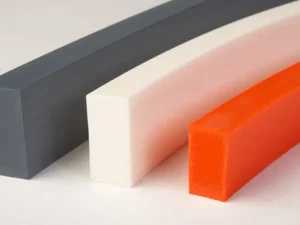What is Silicone Rubber?
Silicone rubber is a highly versatile synthetic elastomer made from silicon, oxygen, carbon, and hydrogen. Unlike natural rubber, it provides superior thermal resistance, flexibility, chemical stability, and biocompatibility. These unique properties make it a preferred material across industries such as automotive, medical, electronics, and construction—especially for producing rubber sealing strips, gaskets, and insulation profiles.
![]()
How is Silicone Rubber Made?
The production of silicone rubber involves five key steps:
- Silicon Extraction: Silicon is derived from silica (SiO₂) through high-temperature reduction.
- Reacting with Methyl Chloride: Produces dimethyldichlorosilane, the foundation for polymerization.
- Distillation: Purifies and separates target compounds.
- Hydrolysis: Water is added to create silanol groups (Si-OH).
- Polymerization: Silanol undergoes condensation to form long-chain silicone polymers.
Classification of Silicone Rubber
– Based on Organic Groups
- Methyl Silicone Rubber – Excellent flexibility, used for sealing strips, medical tubing, O-rings.
- Phenyl Silicone Rubber – Better low-temperature and radiation resistance. Ideal for aerospace, electronics.
- Vinyl Silicone Rubber – Enhanced curing performance; used in custom silicone extrusions.
– Based on Curing Method
- HTV (High Temperature Vulcanized) – Cures above 150°C, highly durable, ideal for industrial seals.
- RTV (Room Temperature Vulcanized) – Cures at room temperature, suitable for prototyping and molds.
- LSR (Liquid Silicone Rubber) – Injected via mold systems, widely used in baby care, medical devices, and food-grade products.
Key Advantages of Silicone Rubber
- High Temperature Resistance (−60°C to 230°C)
- Chemical Stability – Resists oils, solvents, acids, and bases
- UV & Ozone Resistant – Ideal for outdoor environments
- Excellent Elasticity & Flexibility
- Biocompatibility – Safe for medical and food-grade use
- Electrical Insulation – Widely used in electrical sealing parts
- Durability – Long-lasting performance in harsh conditions
Potential Drawbacks of Silicone Rubber
- Higher Cost than standard rubbers
- Low Tear Strength under high mechanical stress
- Limited Color Variety

Therefore, it is important to match the material with the actual application environment.
Applications Across Industries
At Taiwan Okin Huasu Group Limited, we use high-performance silicone rubber to develop advanced rubber sealing strips, flame-retardant seals, and co-extrusion profiles for the following industries:
- 🚗 Automotive Manufacturing – door seals, engine gaskets
- 🏠 Window & Door Systems – insulation sealing profiles
- 🏥 Medical & Healthcare – food-grade, biocompatible seals
- 🔌 Electrical & Electronics – cable gaskets, insulators
- 🧼 Consumer Goods – kitchenware, baby products
FAQ
Q: Is silicone rubber recyclable?
A: Yes, but the recycled product usually has reduced performance.
Q: Is silicone rubber toxic?
A: No. It is widely used in medical and food-grade products due to its safety.
Q: Is silicone rubber better than natural rubber?
A: For high-temperature and chemical applications, yes. However, it is more expensive.
Final Thoughts
Silicone rubber is a smart investment for any manufacturer seeking durable, flexible, and high-performance sealing solutions. If your application involves extreme temperatures, chemical exposure, or requires biocompatibility, silicone rubber is the right choice.
📩 Want to explore customized silicone sealing solutions for your project?
